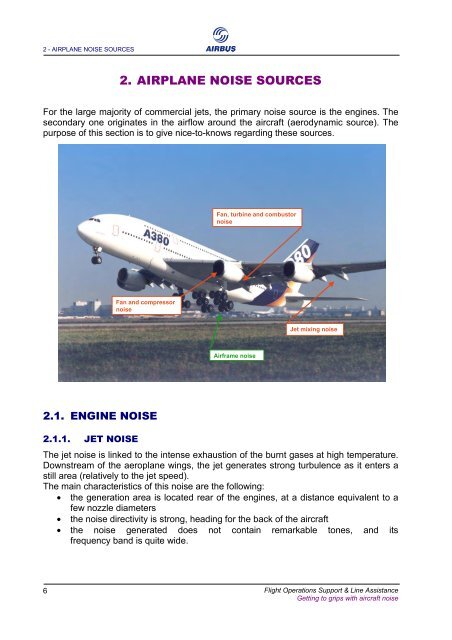Getting to Grips with Aircraft Noise
Getting to Grips with Aircraft Noise
Getting to Grips with Aircraft Noise
You also want an ePaper? Increase the reach of your titles
YUMPU automatically turns print PDFs into web optimized ePapers that Google loves.
2 - AIRPLANE NOISE SOURCES<br />
6<br />
2. AIRPLANE NOISE SOURCES<br />
For the large majority of commercial jets, the primary noise source is the engines. The<br />
secondary one originates in the airflow around the aircraft (aerodynamic source). The<br />
purpose of this section is <strong>to</strong> give nice-<strong>to</strong>-knows regarding these sources.<br />
Fan and compressor<br />
noise<br />
2.1. ENGINE NOISE<br />
Fan, turbine and combus<strong>to</strong>r<br />
noise<br />
Airframe noise<br />
Jet mixing noise<br />
2.1.1. JET NOISE<br />
The jet noise is linked <strong>to</strong> the intense exhaustion of the burnt gases at high temperature.<br />
Downstream of the aeroplane wings, the jet generates strong turbulence as it enters a<br />
still area (relatively <strong>to</strong> the jet speed).<br />
The main characteristics of this noise are the following:<br />
• the generation area is located rear of the engines, at a distance equivalent <strong>to</strong> a<br />
few nozzle diameters<br />
• the noise directivity is strong, heading for the back of the aircraft<br />
• the noise generated does not contain remarkable <strong>to</strong>nes, and its<br />
frequency band is quite wide.<br />
Flight Operations Support & Line Assistance<br />
<strong>Getting</strong> <strong>to</strong> grips <strong>with</strong> aircraft noise


